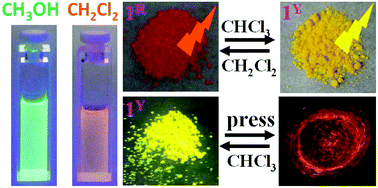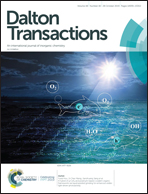Solvent-driven luminescence modulation/switching in an iridium(iii) complex containing an aldehyde group†
Abstract
Complex [Ir(dfppy)2(phca)]PF6 (1) has been synthesized, which contains an aldehyde group in the N^N ligand phca = 1,10-phenanthroline-4-carbaldehyde, with the aim of exploring solvent-driven luminescence modulation/switching in this complex. Complex 1 shows green emission at 514 nm in CH3OH, while orange phosphorescence with the emissions at 516 and 624 nm in CH2Cl2. The solid-state structure of 1 is dependent on the crystallization solvent used, forming a red solid 1R in CH2Cl2, while a yellow solid 1Y in CHCl3. The neighboring [Ir(dfppy)2(phca)]+ cations in solid 1R are held together by π⋯π stacking interactions, while by van der Waals interactions in solid 1Y. The distinct packing structures of 1R and 1Y lead to their significantly different solid-state luminescence, weak orange phosphorescence for 1R (emission at 620 nm, Φ = 3.3%) and strong yellow phosphorescence for 1Y (emissions at 532 and 558 nm, Φ = 46.6%). Both 1R and 1Y show CH2Cl2/CHCl3-driven phosphorescence switching between orange and yellow, due to their structural interconversion through recrystallization. Moreover, the emission color of 1Y can be reversibly switched between yellow and orange through alternate pressing and recrystallization in CHCl3. This work discusses the relationship among the solvent, the structure and the luminescence modulation/switching of complex 1.



 Please wait while we load your content...
Please wait while we load your content...